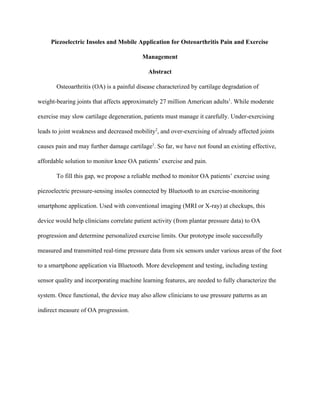
Piezoelectric Insoles and Mobile Application for Osteoarthritis Pain and Exercise Management
- 16. References 1. "ArthritisRelated Statistics." Centers for Disease Control and Prevention. Centers for Disease Control and Prevention, 17 Mar. 2014. Web. 27 July 2015. 2. Lorig, Kate, and James F. Fries. The Arthritis Helpbook. 5th ed. Cambridge: Perseus, 2000. Print. 3. Andriacchi, Thomas P., et al. "A framework for the in vivo pathomechanics of osteoarthritis at the knee." Annals of biomedical engineering 32.3 (2004): 447457. 4. Kellgren, J. H., and J. S. Lawrence. "Radiological assessment of osteoarthrosis." Annals of the rheumatic diseases 16.4 (1957): 494. 5. "Osteoarthritis." Arthritis Foundation. Arthritis Foundation, n.d. Web. 6 Sept. 2015. <http://www.arthritis.org/aboutarthritis/types/osteoarthritis/>. 6. Wertsch, Jacqueline J., John G. Webster, and Willis J. Tompkins. "A portable insole plantar pressure measurement system." J Rehabil Res Dev 29.1 (1992): 1318. 7. Mündermann, Annegret, et al. "In vivo knee loading characteristics during activities of daily living as measured by an instrumented total knee replacement." Journal of Orthopaedic Research 26.9 (2008): 11671172. 8. "Product Documentation for Users." Moticon. Moticon, 2015. Web. 13 Sept. 2015. <http://www.moticon.de/support/documentation>. 9. Moticon GmbH. "OpenGo Science Price List." 27 Nov. 2014. PDF file. 10. "Systems/Software: pedar/pedoport." Novel. Novel Electronics, n.d. Web. 6 Sept. 2015. <http://www.novelusa.com/index.php?fuseaction=systems.pedar>. 11. Rozema, Annet, et al. "Inshoe plantar pressures during activities of daily living: implications for therapeutic footwear design." Foot & ankle international 17.6 (1996): 352359. 12. Mündermann, Annegret, et al. "In vivo knee loading characteristics during activities of daily living as measured by an instrumented total knee replacement." Journal of Orthopaedic Research 26.9 (2008): 11671172. 15
- 17. 13. FornerCordero, A., H. J. F. M. Koopman, and F. C. T. Van Der Helm. "Use of pressure insoles to calculate the complete ground reaction forces." Journal of biomechanics 37.9 (2004): 14271432. 14. FornerCordero, A., H. J. F. M. Koopman, and F. C. T. Van der Helm. "Inverse dynamics calculations during gait with restricted ground reaction force information from pressure insoles." Gait & posture 23.2 (2006): 189199. 15. Hunt, Michael A., et al. "Associations among knee adduction moment, frontal plane ground reaction force, and lever arm during walking in patients with knee osteoarthritis." Journal of biomechanics 39.12 (2006): 22132220. 16. Foroughi, Nasim, Richard Smith, and Benedicte Vanwanseele. "The association of external knee adduction moment with biomechanical variables in osteoarthritis: a systematic review." The Knee 16.5 (2009): 303309. 17. Rodgers, Mary M. "Dynamic foot biomechanics." Journal of Orthopaedic & Sports Physical Therapy 21.6 (1995): 306316. 18. Simple keyboard using the tone() function. Arduino. Arduino, 2015. Web. 6 Sept. 2015. <https://www.arduino.cc/en/Tutorial/Tone3>. 19. “Knock.” Arduino. Arduino, 2015. Web. 6 Sept. 2015. <https://www.arduino.cc/en/Tutorial/Knock>. 20. “SoftwareSerial Library.” Arduino. Arduino, 2015. Web. 6 Sept. 2015. <https://www.arduino.cc/en/Reference/SoftwareSerial>. 21. Schematic of Arduino three tone keyboard. Arduino. Arduino, 2015. Web. 6 Sept. 2015. <https://www.arduino.cc/en/uploads/Tutorial/arduino_fsrs_speaker_schem.png>. 22. Bitar, Hazim. "ArduDroid: A Simple 2Way Bluetoothbased Android Controller for Arduino." TechBitar. N.p., 30 Oct. 2013. Web. 28 July 2015. <http://www.techbitar.com/ardudroidsimplebluetoothcontrolforarduinoandandroid. html>. 23. “Graph.” Arduino. Arduino, 2015. Web. 6 Sept. 2015. <https://www.arduino.cc/en/Reference/Graph>. 16